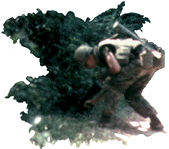The area east of Cu Chi was an enemy corridor into Saigon. But to
get to Saigon, Charlie had to evade our chain of fire bases, outposts, ARVN forts, and
assorted daily sweeps and night ambush patrols. He also had to contend with nightly
helicopter patrols using sophisticated devices to smell, listen and look for the enemy at
night. Many of the fire bases had radar to spot movement beyond its perimeters.
Electronic listening devices were parachuted or planted in remote areas outside of
our immediate control. We also received a great deal of information from the
Vietnamese themselves. Charlie's job was not an easy one.
 On
several occasions I saw the situation room at Cu Chi, where all of the intelligence that
had been gathered was displayed. The room was double height, and one wall contained
a floor to ceiling map of the 25th Division's area of operations. On the board were
enemy troop strengths, locations, unit numbers and origins. There were short memos
with the latest information. One said "Regional VC tax collector moved to this
tunnel last night", another said "four VC met here, then returned to
village". Allied units were moved from one place to another on a daily basis to
counter enemy movement - to search them out, ambush them when they moved at night, or
destroy their hideouts.
On
several occasions I saw the situation room at Cu Chi, where all of the intelligence that
had been gathered was displayed. The room was double height, and one wall contained
a floor to ceiling map of the 25th Division's area of operations. On the board were
enemy troop strengths, locations, unit numbers and origins. There were short memos
with the latest information. One said "Regional VC tax collector moved to this
tunnel last night", another said "four VC met here, then returned to
village". Allied units were moved from one place to another on a daily basis to
counter enemy movement - to search them out, ambush them when they moved at night, or
destroy their hideouts.
To counter these formidable weapons, Charlie used simple but ingenious methods to
conceal his movements and increase his chances for survival. The most incredible of
these was the massive tunnel network set up to provide shelter, places to hide and
regroup, and to act as an underground highway. One tunnel complex discovered in our
area extended more than three miles underground. It began in a heavily forested area
which was a traditional enemy stronghold, burrowed under three major highways, and
resurfaced in a rugged area to the south. It contained mess halls, an infirmary,
recreation areas, and billets for hundreds of soldiers.
Who built these impressive fortifications? The soldiers probably did much of the
work, but labor gangs from the local villages did more than their share. Recruited
at night to "join the struggle against imperialism" (at gunpoint) they built
tunnels, bunkers, and whatever else the enemy needed. We uncovered and destroyed
many tunnels, but there were always more. Considering that their survival depended
on their hiding places, it is easy to see why they kept digging new ones.

Tunnels: Tales Of A War Far Away
Copyright © 1995 Kirk S. Ramsey
Tunnel Entrance Picture Copyright © 1995 Bob Lindgren
Last modified:
March 02, 1995
